There’s nothing better than sleeping in a bed with clean, crisp, white cotton sheets. But over time, those white sheets start to look less white and can develop yellow stains. Even when you know the sheets are clean, the yellow stains can still be unsightly and make the sheets look dirty. But what causes the stains and how can you remove them from your white cotton sheets?
Yellow stains on cotton sheets are mostly caused by body fluids such as oil and sweat building up over time. But they can also be caused by certain products or just yellow with age. To remove yellow stains, you can use common household products such as Borax, vinegar, baking soda, hydrogen peroxide, and lemon juice.
In this article, I’ll discuss all of the potential reasons your white cotton sheets might have yellow stains. I’ll also discuss how to remove yellow stains from white cotton sheets using various products. Finally, I’ll explain how you can prevent yellow stains in the future.
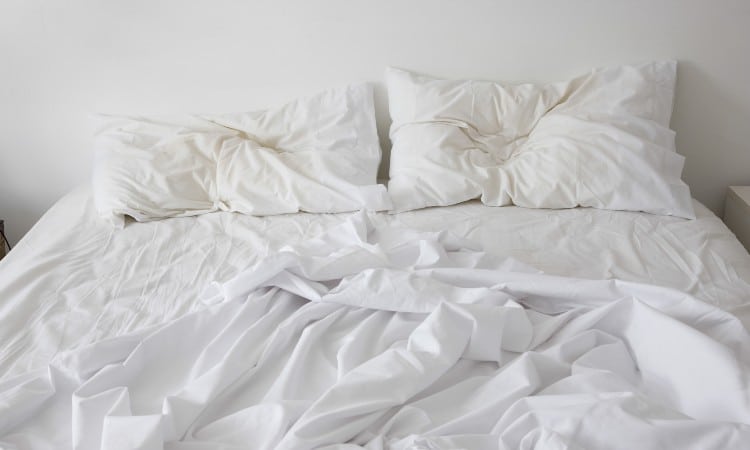
Quick Navigation
What Causes Yellow Stains on Sheets?
Several things can cause white sheets to turn yellow. The biggest reason is natural body oils, sweat, and other fluids building up over time in the fibers of the sheets. Even when the sheets are washed, all of the buildup may still not be removed.
Another reason is due to putting products on your skin before bed. Lotions, moisturizers, etc., can leave behind a residue that can turn the sheets white over time. Also, using bleach every time you wash your white cotton sheets can cause yellow stains due to the chemicals found in the bleach.
Finally, it is possible for some white fabrics to naturally turn yellow over time, especially if they’ve been in storage for a while. Air, or the lack of it, can cause chemical changes in the fibers that result in them turning a dingy yellow color instead of the white that they once were.
How to Remove Yellow Stains from White Cotton Sheets
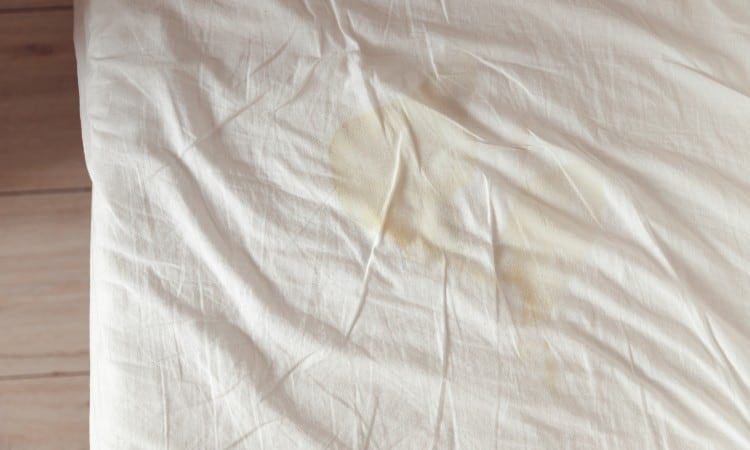
In most cases, you can remove the yellow stains from white sheets and brighten them back up. At the very least, you should be able to temporarily neutralize the yellow color. There are several ways to do this that require very little effort using products that you probably already have at home or that are otherwise affordable and easily available.
1. Borax
 Borax is a popular cleaning agent and laundry product that can be used to remove stains and make white fabrics whiter. It’s a powdery substance that is soluble in water, and the Borax and water combine in a chemical reaction to form a whitening agent.
Borax is a popular cleaning agent and laundry product that can be used to remove stains and make white fabrics whiter. It’s a powdery substance that is soluble in water, and the Borax and water combine in a chemical reaction to form a whitening agent.
The best way to use Borax to remove yellow stains from white cotton sheets is to soak the sheets in a solution of water and Borax. To do this, find a big tub to hold your sheets (such as your bathtub) and fill it up with warm water. Add about ½ to ¾ cups of Borax to the water and let it dissolve.
Place the sheets into the water so that they are fully submerged. Soak them for several hours or overnight for maximum whitening power. Then, take the sheets out and place them in the washing machine. You can add another ½ cup of Borax to the wash along with your regular detergent, if you prefer, then wash the sheets as normal.
2. Vinegar
 White vinegar also has stain removal and whitening properties due to its acidity. Note that it’s very important that you only use white vinegar for this, as apple cider vinegar can leave behind more of a yellow tinge instead of whitening the sheets.
White vinegar also has stain removal and whitening properties due to its acidity. Note that it’s very important that you only use white vinegar for this, as apple cider vinegar can leave behind more of a yellow tinge instead of whitening the sheets.
Fill a big enough tub to hold the sheets with hot water. Add ½ to 1 cup of vinegar to the water, depending on how old and how extensive the yellow stains are. Stir the water so that the vinegar is evenly dispersed.
Add the sheets to the water so that they are fully submerged. Let them soak for a couple of hours, then take them out and place them in the washing machine. You can add another ½ cup of vinegar to the wash along with your detergent, then wash the sheets as normal.
3. Baking Soda
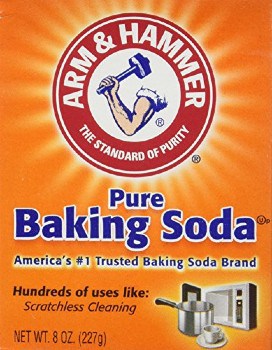 Baking soda can also be effective at whitening sheets, especially those with yellow stains due to a buildup of oils or oily products. It works by absorbing oils and neutralizing the stain to make the fabric whiter. It can also deodorize the sheets as well as make them smell fresher.
Baking soda can also be effective at whitening sheets, especially those with yellow stains due to a buildup of oils or oily products. It works by absorbing oils and neutralizing the stain to make the fabric whiter. It can also deodorize the sheets as well as make them smell fresher.
To use it:
- Add ½ cup of baking soda to the washing machine and your regular laundry detergent. You can use this method by itself or after doing one of the above methods.
- Add a little vinegar to the wash as well for extra whitening power.
- After adding everything to the wash, including the sheets, wash the sheets as normal.
4. Lemon Juice
Lemon juice is also highly acidic and has natural whitening and brightening abilities without using harsh chemicals the way that bleach does. And like baking soda, lemon juice can help deodorize your sheets as well.
It’s best to use lemon juice from a fresh lemon. You’ll need to juice one lemon, then you have two options. The first option is to add the lemon juice to a tub of warm water. Then add your sheets and let them soak in the lemon juice and water for a couple of hours. Wash your sheets, adding baking soda, vinegar, or both to the machine for extra whitening.
Another option is to just pour the lemon juice directly into the washing machine and your detergent. You can add some vinegar as well, as combining lemon juice and vinegar are very effective at breaking down oils and grease. Then, wash the sheets as you normally would.
5. Liquid Bluing
 Another product that you may or may not have at home already that can be used to whiten sheets is liquid bluing. If you don’t already have it, you can pick it up in the laundry aisle at most stores.
Another product that you may or may not have at home already that can be used to whiten sheets is liquid bluing. If you don’t already have it, you can pick it up in the laundry aisle at most stores.
Liquid bluing is a product that is made from a very fine blue powder, water, and a pH balancer, but you can also use a powdered version. It’s designed to “whiten” clothes safely without using harsh chemicals found in bleach.
It’s important to note that liquid bluing doesn’t whiten sheets. Instead, it adds a blue coloring to the fabric that helps to neutralize the yellow because the blue is not noticeable. However, it won’t stay on your sheets forever as it wears off after a few washes.
You’ll have to use this repeatedly if you can’t get the yellow stains out but want the sheets to look white. You’ll also have to dilute it with water before using it. If you add it directly to the machine, it can stain the fabric.
To use it:
- Mix ¼ teaspoon of liquid bluing with a quart of water before adding it to the washing machine.
- Add your sheets and detergent to the water, let the machine fill up with water, and add the bluing directly to the water.
- Wash the sheets as normal.
6. Hydrogen Peroxide
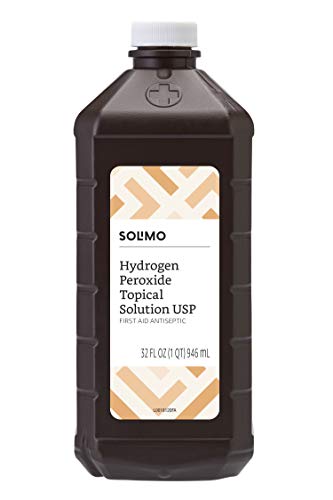 Hydrogen peroxide is another product with natural whitening properties and won’t leave behind any residue on clothing. For best results, you can use it along with baking soda for extra whitening and deodorizing power.
Hydrogen peroxide is another product with natural whitening properties and won’t leave behind any residue on clothing. For best results, you can use it along with baking soda for extra whitening and deodorizing power.
If you haven’t placed the sheets into the washing machine yet, then pour about 1 cup of hydrogen peroxide directly into the drum of the machine. You can also add about ½ cup of baking soda if you prefer.
If the sheets are already in the washing machine, add the hydrogen peroxide to the bleach dispenser, then add the baking soda directly on top of the sheets. After adding the hydrogen peroxide and baking soda, wash the sheets as you normally would.
7. Bleach
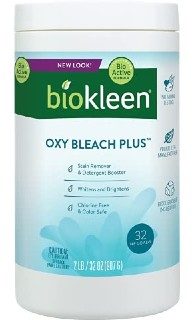 Bleach is one of the causes of white sheets developing yellow stains, especially if you use it every time you wash the sheets, especially if you use chlorine bleach. It does this by weakening the fibers, which dulls the white and turns them a dingy yellow color. This is more common with synthetic polyester fibers, but it can happen with cotton fibers, especially if they have a small percentage of polyester blended in.
Bleach is one of the causes of white sheets developing yellow stains, especially if you use it every time you wash the sheets, especially if you use chlorine bleach. It does this by weakening the fibers, which dulls the white and turns them a dingy yellow color. This is more common with synthetic polyester fibers, but it can happen with cotton fibers, especially if they have a small percentage of polyester blended in.
With that being said, you can still use bleach for whitening sheets occasionally. Oxygen bleach is safer to use than chlorine bleach because it doesn’t contain as many harsh chemicals, but even chlorine bleach can be used occasionally as long as you follow the instructions carefully to make sure that the bleach is properly diluted and gets washed off thoroughly.
Bleach is one of the best options to remove yellow stains from white cotton sheets, provided that the stains weren’t caused by bleach in the first place. But if you use bleach, it is not necessary to use any other products along with it, especially liquid bluing, which could cause both of the products to stain.
When using bleach to whiten anything, sheets included, make sure you use it exactly as the instructions indicated. And avoid using bleach on cotton sheets that are older or yellowed due to age as the fibers are more than likely already weaker and bleach could further damage them.
8. Wash More Than Once
I mentioned washing the sheets at the end of each method above. However, depending on the age, size, and type of yellow stain, you may have to wash them more than once using several methods above. Using more than one of the methods as a process will be most effective at removing yellow stains from your white cotton sheets.
Before washing the sheets in the first place, it’s a good idea to start with a pre-treatment, pre-soak method. You can use either the Borax or vinegar method for this. Use whichever one you have the products for on hand or have the time for. Neither one is necessarily more effective, but the Borax soak takes longer.
After pre-soaking the sheets:
- Do the first wash with either vinegar, baking soda, or lemon juice, or a combination of vinegar and baking soda or vinegar and lemon juice.
- Just don’t use both baking soda and lemon juice because the two products could neutralize each other and make them less effective.
- Add regular detergent to the wash and wash using warm water.
If the yellow stains didn’t come out, you can do a second wash with either liquid bluing or hydrogen peroxide. Again, don’t use both because it may lead to staining. Remember that liquid bluing will only neutralize the yellow if you can’t get it out. Hydrogen peroxide is great if the yellow was removed and you want to give the sheets one final whitening boost.
If nothing else works, you can try washing the sheets a final time using bleach. But remember that using bleach has risks of its own. It’s safer to use oxygen bleach than chlorine bleach. And never use bleach with any other product except for laundry detergent.
9. Air Dry
After washing the sheets, let them air dry, preferably outside in the sun if possible. The sun can help reduce yellowing as it has natural bleaching properties. It can also help to freshen up your sheets as well.
If the sheets have been washed and still look yellow, don’t put them in the dryer unless you’ve tried everything. The heat from the drier can further set the yellow stain into the sheets and make it harder to remove. If nothing else works, you may just have to neutralize the yellow with liquid bluing during every wash.
How to Prevent Yellow Stains on White Cotton Sheets
Once you’ve removed the yellow stains from your white cotton sheets, or if you’ve bought new sheets and want them to stay white, you’ll want to take preventative measures to keep them from developing yellow stains.
Wash Them Regularly
One of the best ways to do this is to wash them regularly. It’s recommended to wash your sheets once per week, but you may have to wash them more often if you have oily skin or sweat at night. At the maximum, wash your sheets every two weeks.
Avoid Using Bleach
When you do wash them, avoid using bleach every single time. Remember that bleach can cause yellowing and other damage. It’s okay to use it occasionally, but you don’t want to use it once a week if that’s how often you wash your sheets.
Change Your Nightly Routine
Other ways to keep your sheets from getting yellow stains, especially if you can’t wash them every week, are to shower before bed and avoid using products on your skin right before bedtime. Doing so can help cut down on the body oils or oily products that your sheets are exposed to.
Sweat is also a combination of natural oil and water, so if you sweat a lot, you may need to wash your sheets more frequently. You can also try keeping the room cooler at night to reduce sweating or wearing more breathable pajama fabrics when you sleep that can help you to stay cooler.
Wash with Other Products
Remember that oils and other products can build up over time in the fibers. With that being said, even washing the sheets with regular laundry detergent may not get them completely clean. It may only remove the oils and other products from the surface of the fabric instead of removing them from inside the fibers as well.
It may be necessary to wash your sheets with some of the products above to keep them at their whitest. Products with high acidity, such as vinegar and lemon juice, can help to break down stains better, and products such as baking soda and Borax can help to neutralize stains and even work with your laundry detergent to provide extra cleaning power.
Although it is easy and less time-consuming to just throw your sheets in the wash with laundry detergent and call it a day, using other products with your laundry detergent can provide a deeper clean. It will also help to keep your cotton sheets looking whiter and fresher for longer so that you can extend their life. That way, you don’t have to spend more time later removing yellowing and you won’t have to replace the sheets as often if you can’t get the yellow stains out.
Conclusion
Yellow stains on your once crisp, clean, and white cotton sheets can be discouraging. But in most cases, they can be removed using common household products. And, you can prevent them altogether by changing your nightly routine and how you wash your sheets. I hope this article was helpful in teaching you how to do just that. If you did find it helpful, share it with others and leave a comment. Thanks for reading!